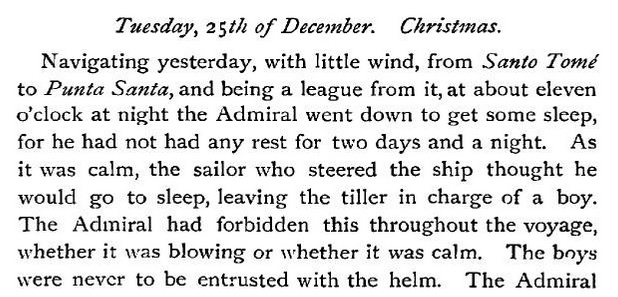In 1453, Christian-controlled Constantinople (now called Istanbul) fell to the Ottoman Empire, and the major trade routes to India and China were closed to Europe. Demand for Eastern goods like silk and spices did not decrease, though, and explorers looked for alternate routes. In 1492, one of those explorers, Christopher Columbus, convinced the government of Spain to sponsor his attempt to find a Western route, across the Atlantic Ocean. Instead, on October 12th, he encountered the Caribbean, mistaking it for the East Indies, and met the indigenous Taíno people.
Columbus initially traded for gold, spices, and slaves (called ‘naborías’ by the Taíno); but found no silks or any other expected Chinese or Indian luxury goods. His first voyage concluded towards the end of the year, and on December 24th he turned his vessels – Santa María de la Inmaculada Concepción, a three masted, one-deck carrack that served as his flagship, and two smaller caravels, the Niña and the Pinta, for home. With much celebration on the Santa María that night, most of the crew retired to bed and only an inexperienced cabin boy was left at the helm, and in the early hours of Christmas morning, the ship ran aground on a sandbar off the coast of Haiti. No lives were lost and some effort was made to save the Santa María by unloading its cargo (an effort aided by Guacanagarí, a Taíno cacique (chieftain), but it was obvious the ship was doomed).

The symbolic death of ‘Saint Mary’ herself on Christmas Day could have been a devastating setback for a crew of superstitious sailors, but Columbus tried to stem the problem by using it for empire-building, scuttling the ship and removing as many timbers as possible to hastily construct a slapdash fort he named La Navidad (the Nativity) as the first permanent European settlement in the New World. He garrisoned over thirty crewmen there (who could no longer fit in the remaining ships) under the governorship of his master-at-arms, Diego de Arana. Its placement established proof of occupation by Spain, which would help with Papal recognition. However, it also signaled to the Taíno that these people were not merely traders but were here to stay.
Although La Navidad was far from secure, Columbus deemed the natives ‘cowardly’ and poorly armed, and thus not a threat. Almost immediately after Columbus set off for home on the Niña, several of the colonists, notably Pedro Gutiérrez and Rodrigo de Escobedo, enslaved as many indigenous women as they could and abandoned the fort to look for gold mines, committing further outrages against the natives as they did so. In retaliation for their abuses, a rival Taíno cacique Caonabo put together a war party and proved Columbus wrong, wiping out every European, de Arana, and even other Taíno who had supported Columbus like Guacanagarí, and burned what had once been the hull of the Santa María to the ground. When Columbus returned on November 27th, 1493 there were only ashes and human remains to greet him, and a long and bloody relationship had begun.
Although Columbus had lost ‘Saint Mary’ at a deeply inauspicious time, he continued to honor her in his voyages. After a storm on the way back to Spain, he vowed that his crew would make a pilgrimage to the first church dedicated to Mary they encountered, which turned out to be a shrine on Santa Maria Island in the Azores. The flagship for his second voyage, in 1493, was named Marigalante (“Gallant Mary”). The Niña returned to the Americas on that journey, alongside her. And in his fourth and final voyage, a new ship, the Capitana, would be renamed the Santa María as well.
For those interested in exploring the early history of native-European contact in the Americas, including the Columbian Exchange, the library offers many resources. Several databases specialize in this, including Early Encounters in North America (covering 1534-1850), which is rich in primary sources; Age of Exploration, which focuses on colonialism, conflict, science, and discovery; and Empire Online, which explores the rise and fall of empires from Columbus’s day to the present, from a global perspective.
Books include Key to the New World: A History of Early Colonial Cuba by Luis Martínez-Fernández, Hispaniola: Caribbean Chiefdoms in the Age of Columbus by Samuel M. Wilson, Islands at the Crossroads: Migration, Seafaring, and Interaction in the Caribbean by L. Antonio Curet, First Encounters: Spanish Explorations in the Caribbean and the United States, 1492-1570 by Jerald T. Milanich, The Journal of Christopher Columbus during His First Voyage, 1492-93 translated by Clements R. Markham, The Columbian Exchange: Biological and Cultural Consequences of 1492 by Alfred Crosby, and World Agriculture Before and After 1492: Legacy of the Columbian Exchange by James F Hancock.
For help locating any resources for any of your research questions, just Ask Us! at iueref@iue.edu or click this button:





